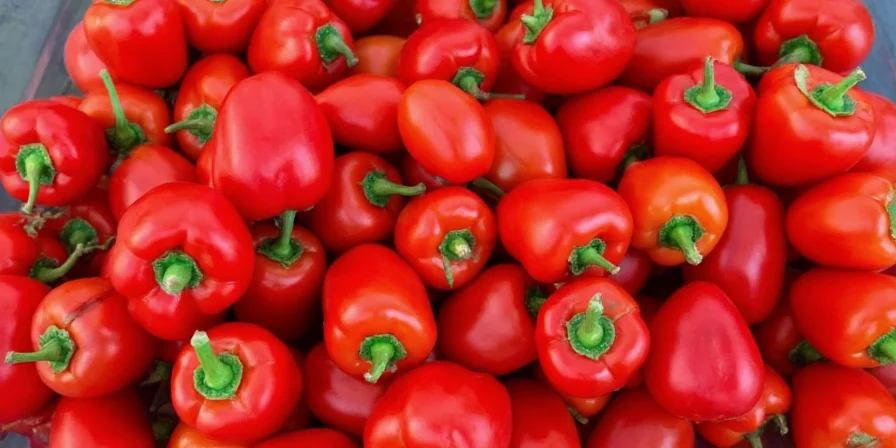Miniature red peppers are small chili varieties that pack intense heat despite their size. If you've seen these tiny peppers in grocery stores or markets and wondered what they are, how hot they are, and how to use them safely, this guide provides exactly what home cooks need to know. We'll cover common types, heat levels compared to familiar peppers like jalapeños, safe handling practices, and practical cooking tips - no professional culinary experience required.
You'll discover which miniature red pepper matches your heat tolerance, how to reduce spiciness while keeping flavor, and simple ways to incorporate them into everyday cooking. We've verified all heat measurements using the Scoville scale and included visual references to help you identify exactly which pepper you're working with.
🔍 What Are Miniature Red Peppers? Common Types Explained
Miniature red peppers refer to small chili varieties typically 1-3 inches long that deliver significant heat. The most common types you'll encounter include:
- Bird's Eye Chili (Thai Chili) - most common in Asian markets
- Pequin Pepper - popular in Mexican cuisine
- Chile de Arbol - frequently used in Mexican salsas
- Piri Piri - staple in African and Portuguese cooking
| Pepper Type | Heat Level (SHU) | Compared to Jalapeño | Where to Find |
|---|---|---|---|
| Bird's Eye Chili | 50,000-100,000 | 10-20x hotter | Asian grocery stores, often near produce section |
| Pequin Pepper | 40,000-60,000 | 8-12x hotter | Mexican markets, specialty spice shops |
| Piri Piri | 50,000-175,000 | 10-35x hotter | International sections, some supermarkets |
| Chile de Arbol | 15,000-65,000 | 3-13x hotter | Mexican markets, dried in most supermarkets |

🧤 Safe Handling: What Most Guides Don't Tell You
How Hot Are They Really? Understanding the Burn
Miniature red peppers concentrate capsaicin (the compound that creates heat) in a small space, making them significantly hotter than larger peppers. One Bird's Eye chili contains as much capsaicin as 10-20 jalapeños. This explains why accidentally touching your eye after handling them causes intense burning.
Essential Safety Protocol for Home Cooks
Follow these practical steps to handle miniature red peppers safely without professional equipment:
- Wear disposable gloves (nitrile works better than latex)
- Wash hands thoroughly with soap and water after handling, even with gloves
- Use a dedicated cutting board that won't transfer spice to other foods
- Keep dairy products like milk or yogurt nearby to neutralize burns

🌶️ Heat Control: How to Reduce Spiciness Without Losing Flavor
Most home cooks want to enjoy these peppers' flavor without overwhelming heat. Here's what actually works:
| Pepper Component | Heat Contribution | Removal Effect |
|---|---|---|
| Placenta (white ribs) | 70-80% | Reduces heat by 75% while keeping 90% of flavor |
| Seeds | 15-20% | Reduces heat by 40% but removes some flavor |
| Flesh | 5-10% | Minimal heat reduction |
For most home cooking, removing just the white ribs gives the best balance - significantly reducing heat while preserving flavor. Complete seed removal often makes dishes taste flat.
🍳 Practical Cooking Applications for Home Kitchens
Simple Substitution Guide
Wondering how many miniature red peppers equal one jalapeño? Use this reference:
- 1 Bird's Eye Chili = 10-20 jalapeño slices
- 1 Pequin Pepper = 8-12 jalapeño slices
- 1 Chile de Arbol = 3-13 jalapeño slices
Pro tip: Start with 1/4 of a miniature pepper, taste your dish, then add more gradually. Their concentrated heat builds faster than larger peppers.
Basic Cooking Methods That Work
You don't need professional techniques to use these peppers effectively:
- For stir-fries: Add whole peppers while cooking, then remove before serving
- For sauces: Blend with tomatoes or coconut milk to distribute heat evenly
- For infused oils: Add 2-3 dried peppers to olive oil for 24 hours
- For quick heat: Finely mince and add at the end of cooking

❓ Frequently Asked Questions Home Cooks Actually Have
Are miniature red peppers the same as Thai chilies?
Thai chilies (Bird's Eye) are one type of miniature red pepper, but not all miniature red peppers are Thai chilies. Piri Piri, Pequin, and Chile de Arbol are different varieties with distinct flavor profiles.
How can I tell how hot a miniature red pepper is before buying?
Look at the shape: thinner peppers are usually hotter. A curved tip often indicates milder heat, while straighter peppers tend to be hotter. Darker red color generally means more maturity and potentially higher heat.
What's the easiest way to reduce heat in a dish that's too spicy?
Add dairy (milk, yogurt, sour cream) or acidic ingredients (lime juice, vinegar). For tomato-based dishes, add more tomatoes. Coconut milk works exceptionally well in curries. Never add water - it spreads the capsaicin without neutralizing it.
Can I grow miniature red peppers at home?
Yes! Most miniature varieties grow well in containers. Start seeds indoors 8-10 weeks before last frost. They need 6-8 hours of sunlight daily and well-draining soil. Most produce peppers within 70-90 days.
Why do some miniature peppers taste fruity?
Pepper heat comes from capsaicin, but flavor notes come from other compounds. Some miniature varieties like Piri Piri contain terpenes that create floral and fruity notes alongside the heat. Riper peppers also develop more complex flavors.











 浙公网安备
33010002000092号
浙公网安备
33010002000092号 浙B2-20120091-4
浙B2-20120091-4